Intel SSD 520 Review: Cherryville Brings Reliability to SandForce
by Anand Lal Shimpi on February 6, 2012 11:00 AM ESTAnandTech Storage Bench 2011
Last year we introduced our AnandTech Storage Bench, a suite of benchmarks that took traces of real OS/application usage and played them back in a repeatable manner. I assembled the traces myself out of frustration with the majority of what we have today in terms of SSD benchmarks.
Although the AnandTech Storage Bench tests did a good job of characterizing SSD performance, they weren't stressful enough. All of the tests performed less than 10GB of reads/writes and typically involved only 4GB of writes specifically. That's not even enough exceed the spare area on most SSDs. Most canned SSD benchmarks don't even come close to writing a single gigabyte of data, but that doesn't mean that simply writing 4GB is acceptable.
Originally I kept the benchmarks short enough that they wouldn't be a burden to run (~30 minutes) but long enough that they were representative of what a power user might do with their system.
Not too long ago I tweeted that I had created what I referred to as the Mother of All SSD Benchmarks (MOASB). Rather than only writing 4GB of data to the drive, this benchmark writes 106.32GB. It's the load you'd put on a drive after nearly two weeks of constant usage. And it takes a *long* time to run.
1) The MOASB, officially called AnandTech Storage Bench 2011 - Heavy Workload, mainly focuses on the times when your I/O activity is the highest. There is a lot of downloading and application installing that happens during the course of this test. My thinking was that it's during application installs, file copies, downloading and multitasking with all of this that you can really notice performance differences between drives.
2) I tried to cover as many bases as possible with the software I incorporated into this test. There's a lot of photo editing in Photoshop, HTML editing in Dreamweaver, web browsing, game playing/level loading (Starcraft II & WoW are both a part of the test) as well as general use stuff (application installing, virus scanning). I included a large amount of email downloading, document creation and editing as well. To top it all off I even use Visual Studio 2008 to build Chromium during the test.
The test has 2,168,893 read operations and 1,783,447 write operations. The IO breakdown is as follows:
| AnandTech Storage Bench 2011 - Heavy Workload IO Breakdown | ||||
| IO Size | % of Total | |||
| 4KB | 28% | |||
| 16KB | 10% | |||
| 32KB | 10% | |||
| 64KB | 4% | |||
Only 42% of all operations are sequential, the rest range from pseudo to fully random (with most falling in the pseudo-random category). Average queue depth is 4.625 IOs, with 59% of operations taking place in an IO queue of 1.
Many of you have asked for a better way to really characterize performance. Simply looking at IOPS doesn't really say much. As a result I'm going to be presenting Storage Bench 2011 data in a slightly different way. We'll have performance represented as Average MB/s, with higher numbers being better. At the same time I'll be reporting how long the SSD was busy while running this test. These disk busy graphs will show you exactly how much time was shaved off by using a faster drive vs. a slower one during the course of this test. Finally, I will also break out performance into reads, writes and combined. The reason I do this is to help balance out the fact that this test is unusually write intensive, which can often hide the benefits of a drive with good read performance.
There's also a new light workload for 2011. This is a far more reasonable, typical every day use case benchmark. Lots of web browsing, photo editing (but with a greater focus on photo consumption), video playback as well as some application installs and gaming. This test isn't nearly as write intensive as the MOASB but it's still multiple times more write intensive than what we were running last year.
As always I don't believe that these two benchmarks alone are enough to characterize the performance of a drive, but hopefully along with the rest of our tests they will help provide a better idea.
The testbed for Storage Bench 2011 has changed as well. We're now using a Sandy Bridge platform with full 6Gbps support for these tests.
AnandTech Storage Bench 2011 - Heavy Workload
We'll start out by looking at average data rate throughout our new heavy workload test:
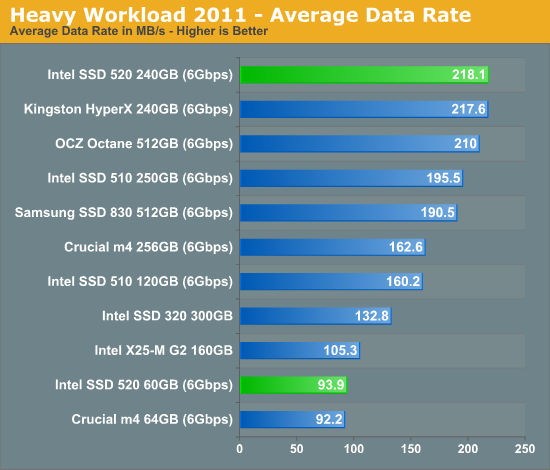
SandForce has always done well in our Heavy Workload test, and the 520 is no different. For heavy multitasking workloads, the 520 is the fastest SSD money can buy. Note that its only hindrance is incompressible write speed, which we do get a hint of in our breakdown of read/write performance below.

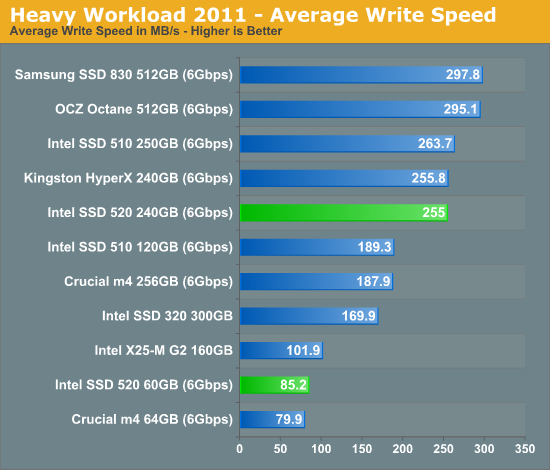
The next three charts just represent the same data, but in a different manner. Instead of looking at average data rate, we're looking at how long the disk was busy for during this entire test. Note that disk busy time excludes any and all idles, this is just how long the SSD was busy doing something:
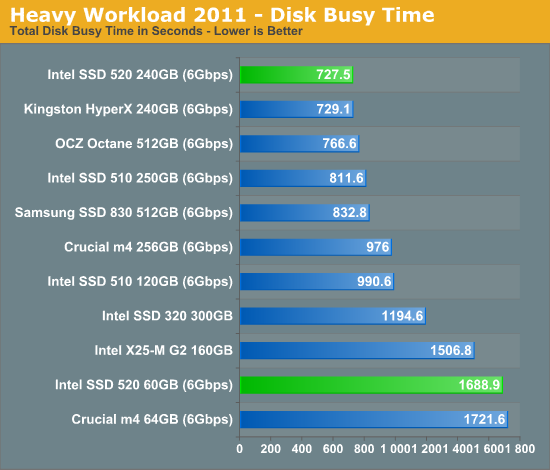
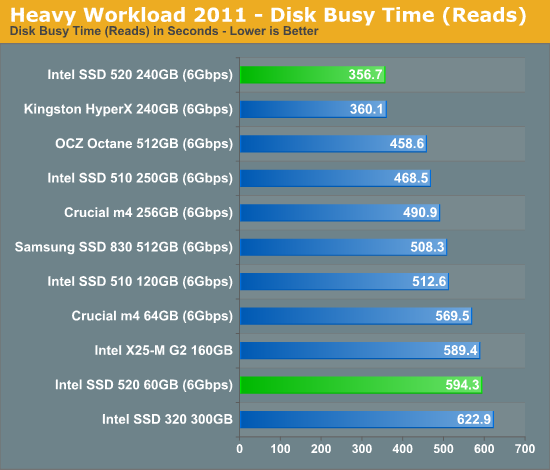
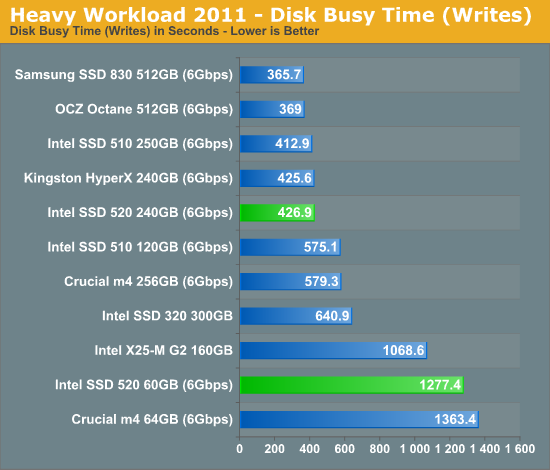










138 Comments
View All Comments
borynek - Saturday, February 11, 2012 - link
I am very curious how does the encryption option work in Intel SSD 520? Does it use ATA password? When I connect it to another computer or via USB the data cannot be read?schouwla - Monday, February 13, 2012 - link
I am not very excite about the new SSD from Intel. How does it stack up against A-DATA AS510S3-120GM-C that has reads at 550 MB/S and writes at 510 MB/S. A 120G disk is 11500 yen in JapanMadMacMan - Monday, February 13, 2012 - link
I'm what you would call a "power user" I suppose and I've used SSD's for several years. I had an X25-M G1 for the longest time and when Intel decided not to go after the speed crown anymore after the X25-M G2, and instead focus on reliability with the 320, I jumped ship. I love the fact that Intel is BACK with the 520 and although I'm surprised at the controller choice (SF-2281), it's still Intel and while only time will tell if it will have been a good purchase, but I'm going to get the 180GB version of the 520 series.I do have some experience with SF-2281 drives and they are all positive. At first, I was using two 120GB OWC Mercury EXTREME Pro 6G SSD's in RAID 0 in a 2011 Mac mini, which has SATA III (6Gbps) support. They ran like a dream using Apple's software RAID 2.0. Sequential speed tests for reads and writes were consistently above 900MB/s and sometimes approaching the 1GB/s mark, although I never went over. This setup lasted 3 months when I attempted to do the same when I switched into my (Late-2011) 17" MacBook Pro, but due to an issue having SOLELY to do with Apple, I am restricted to using only one of my SSD's. Needless to say, speeds dropped to around 500MB/s, but my machine runs beautifully and is still kick-ass at those rates. (On a side note, when I researched the issue, the 13" MBP, for some inexplicable reason, DOES run beautifully with 2 SSD's from OWC (i.e. SF-2281) in RAID 0, but not the 15" and 17" ones. As I said, this has NOTHING to do with the fact that they are SF-2281 drives.
The bottom line here is that I have had a combined 6 months experience with specifically the SF-2281 from OWC and they have been flawless for me and again, my system is on 24/7 and gets plenty of use. To give you an idea just how much use, I upgraded to 16GB of RAM recently, because 8GB simply wasn't enough.
So as I said, I will sell both of my 120GB OWC drives to raise some money for one of these, most likely the 180GB version. According to one of the charts in the review, the 180GB and 240GB run at almost the exact same speed (as opposed to the 120GB and 60GB variants). That's a sweet spot for me as far as capacity and price point are concerned. I'm looking forward to going back to Intel, although OWC's drives have been great!
e-kirill - Thursday, February 16, 2012 - link
I am thinking about buying Intel 520 180GB for my iMac 27" (mid 2011, MC814, OS X Lion 10.7.3), going to swap factory HDD with sweet (?) Intel 520.What do you think, guys, is it a good choice, considering NO TRIM factor for non-factory SSD under OS X Lion?
Yes, I know about TRIM Enabler (http://www.anandtech.com/show/5453/trim-enabler-20... but I am just ... not sure, how will it work over time.
It would be great to know your thoughts.
Thanx in advance!
SezeMakto - Friday, February 17, 2012 - link
First post ever! I'm torn between 3 SSDs. The Samsung 830 256GB for $340 delivered, the Samsung 830 512GB for $675 delivered, or an Intel 520 240GB for $500 delivered... Any help? Thanks.TheJian - Friday, March 2, 2012 - link
You report Trim doesn't do squat with this drive. Then how do they report trim works in seconds here using SSD Optimizer. You can even set it to scheduled so you don't worry about trim any more:http://www.hardwarecanucks.com/forum/hardware-canu...
If this is true, your whole article needs to be changed to say it's the best drive out there with trim or without even in XP etc.
Am I wrong? I almost bought but now want intel instead. Your article almost steered me to M4 just to avoid sandforce. I'm rethinking that now as maybe Intel really is WORTH the money.
TRIM WORKS FINE ON THIS DRIVE. USE THE TOOLBOX. How did you miss this??
zenith1 - Monday, March 12, 2012 - link
"Performance in this worst case scenario isn't terrible but the fact that it's irrecoverable even after a TRIM is what's most troubling."I am a bit unsure about this worst case scenario, does this mean that if I get into this corner case, there is no way at all to restore the drives performance? It will not help to free up some space or, as a last resort, a secure erase?
Would not mind any pointers on this issue, if it has been thoroughly discussed before. Just a bit mind boggling if there is no solution to this problem.
cansande - Thursday, March 15, 2012 - link
A couple of days ago the price was around 206 for the 120. It dropped to 199 and then 179 today. It looks like Intel may start to be more competitive with ocz and others. 10 dollars more than a vertex 3. Reliability and a 5 year warranty is 10 dollars more. I'll take it.kzinti - Monday, April 16, 2012 - link
I got myself an Intel 520 SSD (180GB) two weeks ago. While installing windows, I got 2 BSOD (dreaded F4), both resuming from hibernate. So I dissable hibernate and any power saving option. The drive worked fine for a week (so I forgot all about it).Then I started getting random freeze and last night, BSOD (F4) within 10 min of each reboot.
This was on an Asus P5K Deluxe, Bios updated to 1005 and ICH9R controller to 8.7.0.1007.
I put back my old system drive to reformat the SSD and that took me a dozen attempt. The SSD drive would keep locking up and disconnecting.
Since I removed the SSD, my system is stable as it always' been.
I am returning it today. I sure hope these new drives aren't plaggued with the same problem.
kzinti - Wednesday, April 18, 2012 - link
Exchanged the faulty SSD and haven't had a single problem in 3 days. The shop guy was genuinely surprised and said no one ever returned an Intel SSD. Well, I guess now there is one. =)